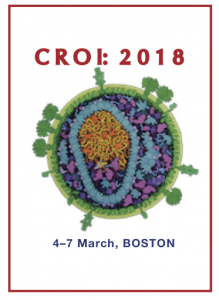Doubling raltegravir dose could overcome interaction with rifampicin in children aged 2 to 6
16 April 2018. Related: Conference reports, Paediatric care, PK and drug interactions, TB coinfection, CROI 25 (Retrovirus) 2018.
 Polly Clayden, HIV i-Base
Polly Clayden, HIV i-Base
Doubling the dose of raltegravir for children aged two to six years with TB and HIV co-infection who were taking rifampicin achieved adequate concentrations and was found to be safe. Results from IMPAACT P1101 were presented at CROI 2018.
A dose of 12 mg/kg of raltegravir (RAL) can be used for TB-HIV co-infected children taking rifampicin in this age group.
IMPAACT P1101 is a phase 1/2 dose finding study of RAL for HIV positive children receiving rifampicin (RIF)-containing TB treatment for at least one week. The study has three age cohorts: cohort 1: 2 to <6 years (results shown here), cohort 2: 6 to <12 years of age and cohort 3: 4 weeks to <2 years. Each cohort needs 12 participants for pharmacokinetic (PK) and safety evaluations.
Participants start a three-drug ART regimen at enrolment, including chewable RAL formulation at 12 mg/kg/dose twice daily (twice the recommended paediatric dose).
Intensive RAL PK sampling is performed one week after ART is started and then a forth ARV is added to the regimen – standard of care with TB treatment, usually efavirenz or lopinavir/ritonavir.
RAL is stopped when TB treatment is completed and participants followed for a further three months. PK targets are a geometric mean (GM) AUC12h of 6–20 mgxh/L (14–45 uMxh) and GM C12h > 33 ng/mL (>75 nM). The study defines virologic success as at least 1 log10 copies/mL reduction from baseline or viral load <400 copies/mL at week 8.
The 12 participants were 7 (58%) male, 100% black and median age of 3 years (IQR: 2 to 5). Median baseline viral load 4.91 log10 copies/mL (IQR: 4.42 to 5.42), CD4 count 559 cells/mL (IQR: 390 to 1185) and CD4 per cent 15% (IQR 9–24). Median follow up was 33 weeks (IQR: 28 to 37). The majority of participants (11/12) received efavirenz as the forth drug and one participant received lopinavir/ritonavir.
At week 1 GM AUC12h was 12.8 mgxh/L (28.8 uMxh; CV 50%) and GM C12h was 102 ng/mL (230 nM; CV 76%).
Median CD4 change from baseline was 101cells/mm3 and 6.1%.
One participant had grade 3 AST and grade 3 ALT elevations at week 4 judged possibly related to RAL. RAL/ART was temporarily stopped for 21 days and then restarted, with no recurrence.
At week 8 11/12 (92%) participants achieved virologic success and 9/12 (75%) viral load <50 copies/mL; 10/11 remained <400 copies/mL through week 24. The participant who did not achieve virologic success was the same one that stopped ART temporarily.
comment
These data are welcome as options for treating coinfected children are scarce.
Results from cohorts 2 and 3 are needed before the double dose of RAL can be recommended for all TB-HIV co-infected infants and children treated with rifampicin.
Reference
Myers T et al. P1101: phase I/II study of raltegravir containing regimen in HIV-TB cotreated children. 25th Conference on Retroviruses and Opportunistic Infections (CROI 2018), 4–7 March 2018, Boston. Poster abstract 845.
http://www.croiconference.org/sessions/p1101-phaseiii-study-raltegravir-containing-regimen-hiv-tb-cotreated-children (abstract and poster)

